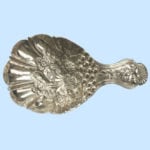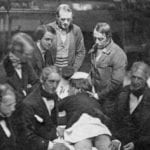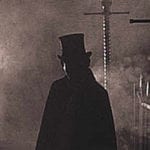 Weird Stuff
Weird Stuff  Weird Stuff
Weird Stuff  Our World
Our World 10 Ways Your Christmas Tree Is More Lit Than You Think
 Movies and TV
Movies and TV The 10 Coolest Stars to Set Sail on The Love Boat
 History
History 10 Things You Didn’t Know About the American National Anthem
 Technology
Technology Top 10 Everyday Tech Buzzwords That Hide a Darker Past
 Humans
Humans 10 Everyday Human Behaviors That Are Actually Survival Instincts
 Animals
Animals 10 Animals That Humiliated and Harmed Historical Leaders
 History
History 10 Most Influential Protests in Modern History
 Creepy
Creepy 10 More Representations of Death from Myth, Legend, and Folktale
 Technology
Technology 10 Scientific Breakthroughs of 2025 That’ll Change Everything
 Weird Stuff
Weird Stuff Ten Bizarre Facts About The Doge Meme
 Our World
Our World 10 Ways Your Christmas Tree Is More Lit Than You Think
 Movies and TV
Movies and TV The 10 Coolest Stars to Set Sail on The Love Boat
Who's Behind Listverse?

Jamie Frater
Head Editor
Jamie founded Listverse due to an insatiable desire to share fascinating, obscure, and bizarre facts. He has been a guest speaker on numerous national radio and television stations and is a five time published author.
More About Us History
History 10 Things You Didn’t Know About the American National Anthem
 Technology
Technology Top 10 Everyday Tech Buzzwords That Hide a Darker Past
 Humans
Humans 10 Everyday Human Behaviors That Are Actually Survival Instincts
 Animals
Animals 10 Animals That Humiliated and Harmed Historical Leaders
 History
History 10 Most Influential Protests in Modern History
 Creepy
Creepy 10 More Representations of Death from Myth, Legend, and Folktale
 Technology
Technology 10 Scientific Breakthroughs of 2025 That’ll Change Everything
10 Really Peculiar Victorian Deaths
Death is always a tragedy to those who have lost someone close to them. Sometimes, though, it’s hard for the rest of us to keep a straight face, particularly when people die in a ridiculous way. And there’s no shortage of ridiculous deaths through history.
The Victorians, who took death so seriously, must have struggled even harder. Their sense of propriety and strict decorum combined with their morbid obsession with death must have made attending any funeral difficult. On that note, attending any of the following people’s funerals must have been extremely challenging.
10 The Man Who Swallowed A Mouse

Factories in Victorian England were not hygienic places. Mills especially attracted a large number of vermin. So it should not really have come as too much of a surprise when a mouse ran across the work table of one young factory girl in 1875.
Perhaps, however, the girl was taken by surprise, for she let out a piercing scream, and one of her colleagues dashed across to help her. He managed to catch the mouse, but it soon wriggled out of his hand and disappeared up his sleeve. The gallant young man gasped in surprise as the mouse suddenly reappeared from under his collar, and the mouse, seeking a dark hole in which to hide, promptly jumped into his open mouth and down his throat.
The Manchester Evening News reported that “a mouse can exist for a considerable time without much air [ . . . ] the mouse began to tear and bite inside the man’s throat and chest, and the result was that the unfortunate fellow died after a little time in horrible agony.”[1]
9 The Man Killed By His Alarm Clock
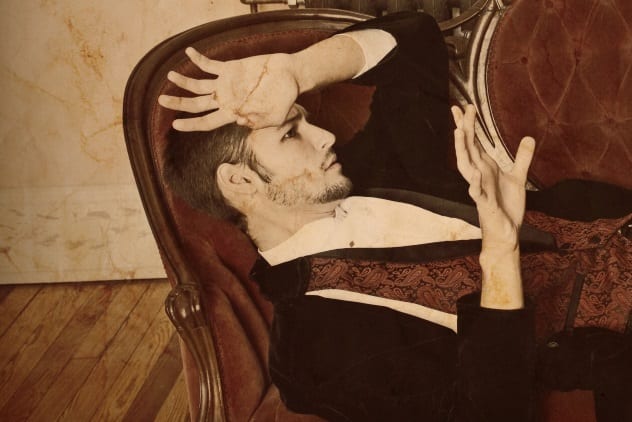
Sam Wardell was a lamplighter in Flatbush (part of Brooklyn in New York City) in the mid-1880s. Lamplighters would take ladders around to light the gas-powered street lamps at dusk and return at dawn to extinguish them. They also sometimes served the additional role of waking the local inhabitants to tell them it was time to get up.
Perhaps Sam Wardell was one of those people who had trouble waking up in the mornings. To ensure that he wouldn’t sleep through his alarm, he took his alarm clock and added some, shall we say, modifications. He fixed a wire to the clock and attached the other end to a shelf. Then he placed a 4.5-kilogram (10 lb) stone on top of the shelf. Then he rigged the shelf so that every time the alarm went off, the shelf collapsed and the stone would crash to the floor and wake him up. Presumably, he had solid floors and no neighbors.
The system worked perfectly until Christmas Eve 1885, when he invited some friends to his one-room apartment for a party. In order to make room for them to dance, Wardell pushed his furniture to the walls.
It must have been a good party, because Wardell climbed into bed afterward without replacing the furniture.
The following morning, his alarm went off. His shelf fell. And the stone dropped straight onto his head, killing him, well, stone dead.[2]
8 The Man Killed By A Coffin
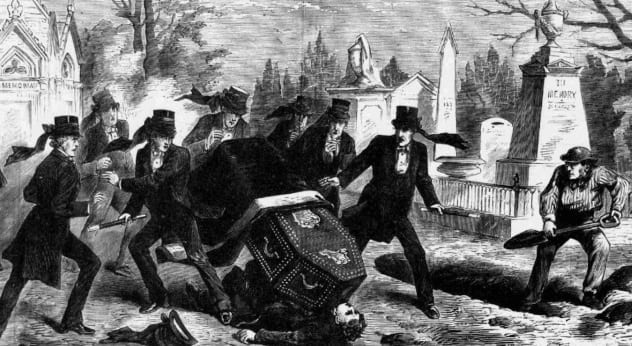
Pallbearing is not known for being a particularly dangerous occupation. However, for Henry Taylor of London, it was the death of him.
In 1872, he was performing his duties at the graveside on a wet day. The ground was slippery, so to avoid embarrassing accidents, mourners were requested to access the grave on foot to lighten the load on the funeral carriage. The coffin was removed from the hearse and was being carried gingerly by six pallbearers in solemn fashion. As they approached the grave, the pallbearers were ordered to turn so that the coffin would be facing the right way when it was lowered into the ground.
As the six men shuffled around in a circle carrying the coffin, a rather heavy one by all accounts, Taylor slipped on the muddy ground, upsetting the other pallbearers in the process. To prevent themselves from falling, the others let go of their burden, and the coffin fell full-force on top of Henry Taylor, killing him.[3]
7 The Woman Who Killed herself With Color
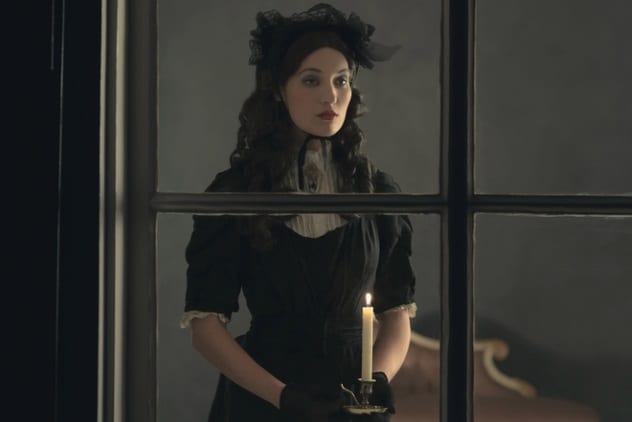
People have always been willing to suffer to be fashionable, but for the Victorians, there were few lengths to which people would not go in order to look their best. After Empress Eugenie wore a stunning green dress to the Paris Opera in 1864, green was in. Everyone who was anyone wanted to be seen in the same emerald green shade as the princess.
It was unfortunate that that particular shade of green was created by mixing copper with arsenic. The color became so popular that it was used in fabrics everywhere. Deaths soon followed.
In 1861, Matilda Scheurer, a maker of artificial flowers, died of accidental poisoning after dusting the flower petals with “green powder.” Though her death and its cause were described in grisly detail in newspaper articles, the fashion for Paris green continued.
As its lethal properties were public knowledge, it is not, perhaps, surprising that when Louisa Cruikshank decided to kill herself, she thought of the colorful substance. In 1882, at just 18 years old, Miss Cruikshank purchased the poison without any difficulty from an art supplies shop and died swiftly but painfully soon afterward.[4]
6 The Man Who Swallowed A Billiard Ball

The Victorians, alas, did not have the monopoly on stupid people. And stupid drunk people are apt to behave in the same way today as they did then. But, in an age when people had to make their own amusements, some found greater scope for doing ridiculous things. Take Londoner Walter Cowle, for instance.
In 1893, while enjoying a night out, he bet his friends that he could put a billiard ball in his mouth and close his lips around it. At the subsequent inquest, the landlord of the Carlisle Arms Tavern maintained that when he provided Cowle with a billiard ball, it was on the understanding that he would not actually put the ball in his mouth but only appear to do so, while using sleight of hand to palm the ball in his pocket.
For some reason, however, perhaps in some way connected to the large number of drinks that the landlord at the tavern had served, Cowle did indeed put the ball in his mouth, whereupon he immediately began to choke. Both his drinking companion and the landlord tried to remove the billiard ball, even holding Cowle upside down and slapping him on the back, but nothing worked.[5]
Though, at the inquest, his friends maintained that they had seen Cowle perform this trick several times, the landlord of the tavern had nothing else to say on the matter. And neither, of course, did Cowle.
5 The Lady Who Danced In Her Shroud
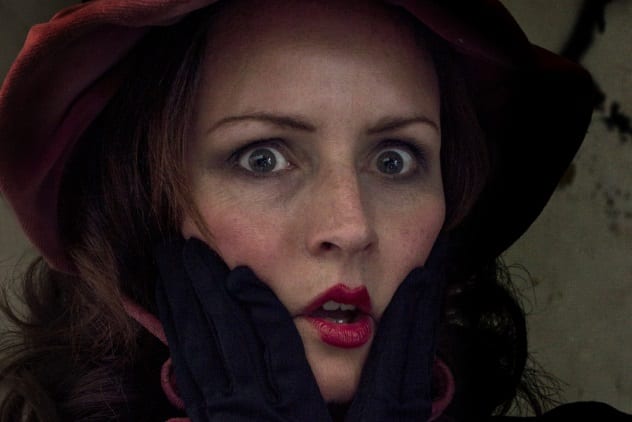
When Mrs. Marion Hillitz died in 1878 after a long, entirely normal illness, her friends and relatives gathered to pay their respects ahead of the funeral. Her body was laid out in her coffin, and mourners sat around the corpse praying or talking in subdued voices.
So it must have come as something of a shock when Mrs. Hillitz suddenly sat up in her coffin and addressed the company. She surveyed her family and friends, soberly attired in black, and announced, “I am not dead yet, but I will die soon.”
According to newspaper reports, Mrs. Hillitz then climbed out of her coffin and “danced around the room, sang, and shouted in a loud, ringing voice” as the mourners presumably stared in disbelief—and probably a fair amount of terror.
However, the miracle was not long-lasting. Her nurses, once they had gotten over the shock, put the old lady to bed, where she died, for real, later that night.[6]
4 The Man Stabbed As Part Of The Act
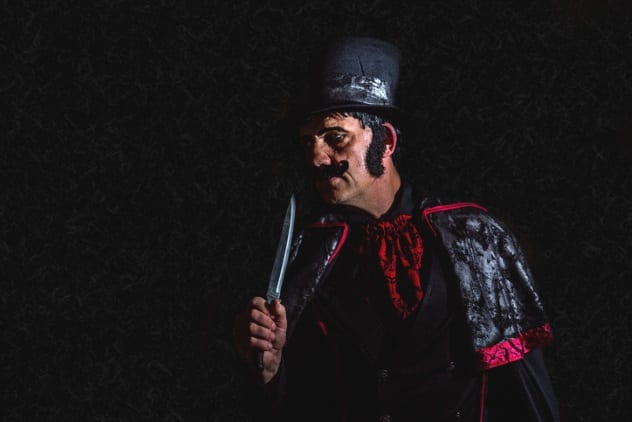
In 1896, while performing in a new play at the Novelty Theatre in London, Temple Edgecumbe Crozier (his real name, apparently) was killed when a fellow actor stabbed him during his debut performance of The Sins of the Night.[7]
For some reason, the prop dagger had been replaced with a real one. As a result, when his fellow actor uttered the words, “Die villain, die,” and stabbed him enthusiastically during the final scene, the blade pierced Crozier’s heart and killed him.
For obvious reasons, The Sins of The Night was not a success, and its run was an extremely short one.
3 The Servant Who Died Reenacting A Death
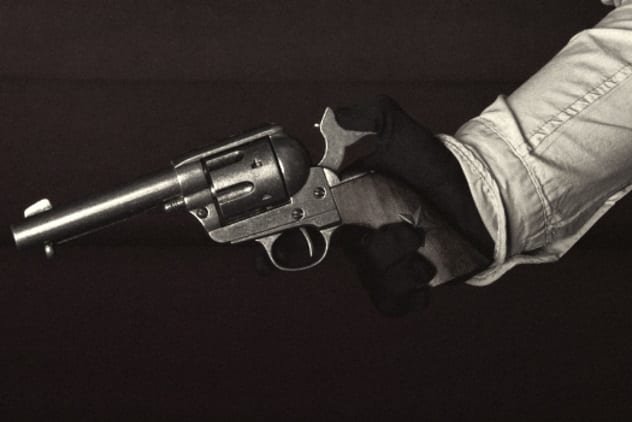
In October 1881, a man asked his servant to collect a gun that he intended to give someone as a gift. The servant, a dim-witted chap called Hague, went to collect the revolver and, while there, decided to examine it closely. For reasons best known to himself, Hague lifted the gun up to his face to examine the trigger mechanism and somehow managed to shoot himself in the mouth. The wound was instantly fatal.
Another servant, witnessing the accident, called the police. After their arrival, she picked up the gun to demonstrate to the officers just how the incident had occurred.
As Hague had done, she lifted the gun to her face to examine it, and, just like Hague, she managed to pull the trigger. The bullet went through her mouth, and she, too, died, which must have made things a lot clearer for the police.[8]
2 The First Motor Vehicle Fatality
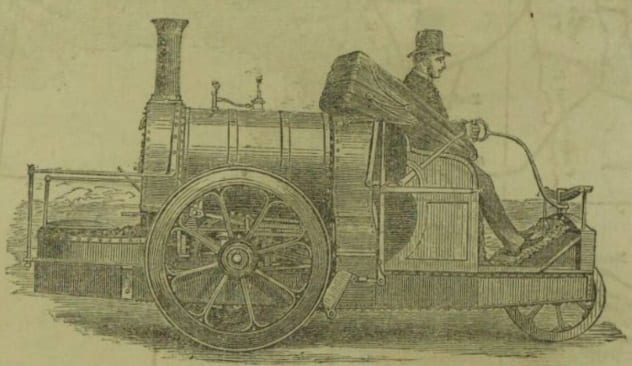
Today, traffic accidents are, unfortunately, a daily occurrence. In 1869, there had never been a death by motor vehicle, until August 31, when Mary Ward became the first-ever casualty of the automobile. At that time, automobiles were called “road locomotives” and were little more than steam trains with rubber tires attached, weighing approximately 1.5 metric tons.
Mary Ward was a remarkable woman who had done pioneering work in the fields of science and astronomy. She must have had a curious mind, because she jumped at the chance to ride in her husband’s new car.
Though the car was only traveling at 6.4 kilometers per hour (4 mph), Mary fell from the passenger seat as the vehicle took a sharp bend, and the enormous back wheel ran straight over her. Newspaper reports that said she died of “dislocation of the neck” were no doubt being discreet.[9]
1 The People Who Died Of A Sweet Tooth

Sugar has long been known to be an addictive substance. And, as with all addictive substances, demand sometimes outstrips supply. In Victorian Britain, the price of “white gold” was very high, and so, enterprising grocers often cut their products with cheaper substances. How times have changed.
The cheap powder used to cut sugar was known as “daft” or “daff” and usually consisted of substances such as plaster of Paris or powdered limestone.
In 1858, one sweet seller, known to all as “Humbug Billy,” operated a sweet stall in Bradford in the north of England. His suppliers, when purchasing the daft with which to cut their product, had accidentally bought 5.4 kilograms (12 lb) of arsenic and not the plaster of Paris that they thought they were getting.[10]
Unaware of the mistake, Humbug Billy sold the sweets from his stall. He sampled the sweets and was ill himself, but rather than destroying the stock, he negotiated a discount and carried on with the sale. Enough sweets were sold to have killed 2,000 people, but, thanks to the quick work of the town crier, who alerted the locals as soon as the source of the illness was known, only 21 people died, though another 200 had to be treated for arsenic poisoning.
Ward Hazell is a writer who travels, and an occasional travel writer.
Read more about death in the Victorian era on 10 Fascinating Death Facts from the Victorian Era and 10 Strange Mourning Items From The Victorian Era.



